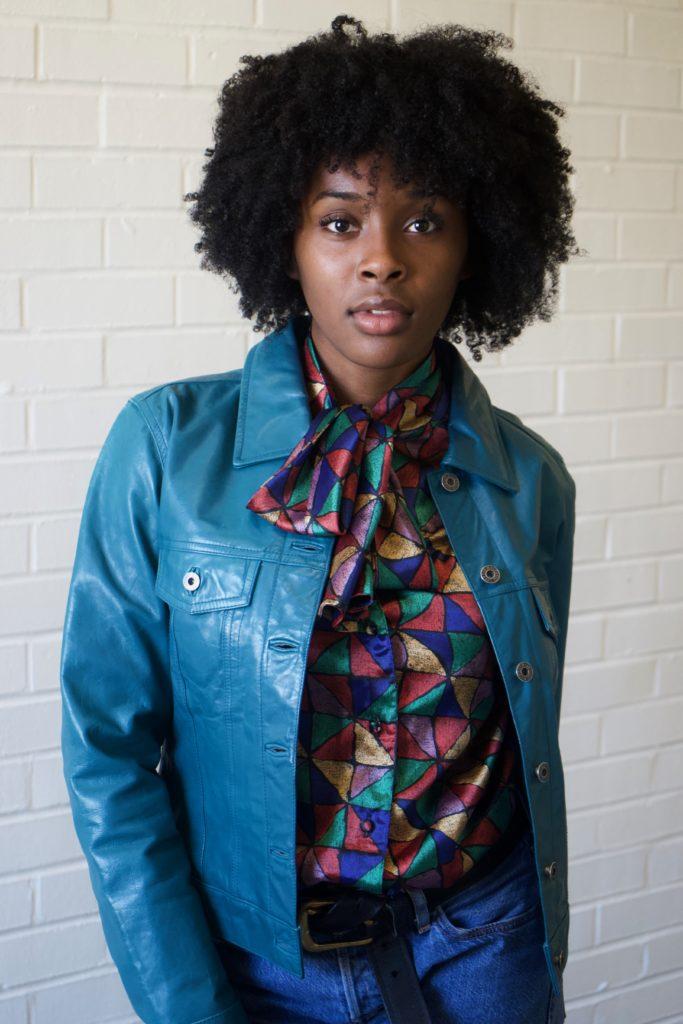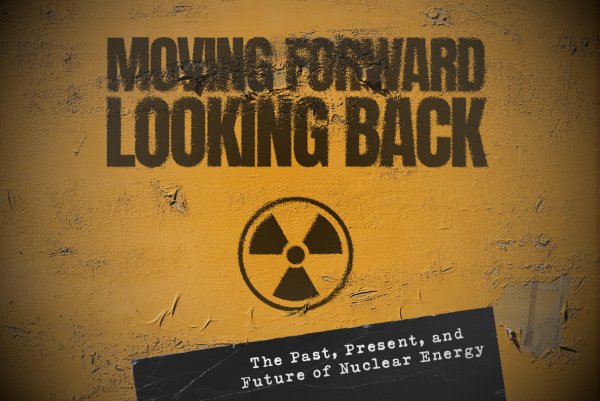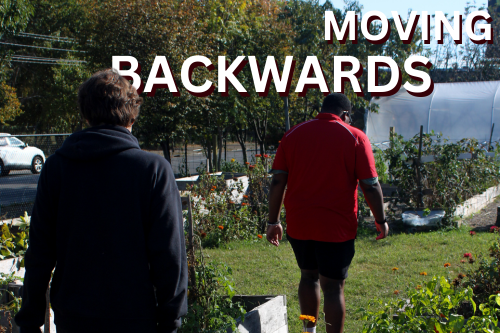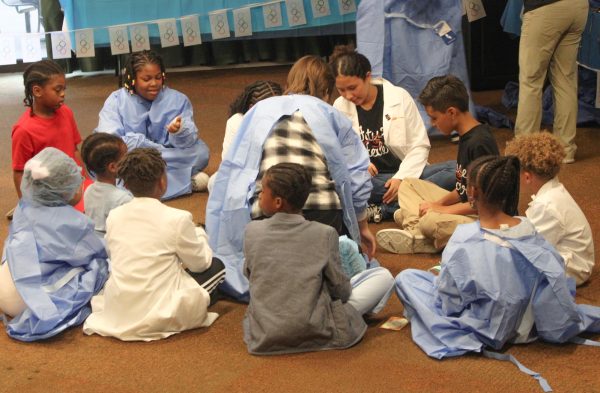Not What it Seams- How the truths of fast fashion made me change the way I shop

Faith Lindsey, a 16-year-old duPont Manual High School sophomore, wears thrifted and altered clothing. “It’s more sustainable and it looks great,” Lindsey said. Photo by Marshall Gault
At seven years old, I became the first model for a young and budding designer. There were no deals or contracts, just love and raw creativity. That designer was my big brother, Zach Lindsey. You may know him as a contestant on “Project Runway: Junior” — or just as the dude who remains fly no matter the circumstance — but I know him as the little kid who stole my Barbie dolls to dress them himself. Eventually, he upgraded from the Barbies and started using me as his doll.
He pinned old curtains, tablecloths, and scrap fabrics to my fidgety body as I rebelled against every action. Every time would end with crying, violent screaming fits, and one of us yelling, “I hate you! I’ll never do this again,” stomping away and slamming the door behind us. Of course, the next day I’d be back in his room admiring his work and planning our next in-house fashion show. The shows would consist of me strutting down the hallway to any Beyonce track we were feeling at the moment, and illuminating his designs with every lamp and flashlight we could find.
Now he’s 19, struggling to pay the bills in Brooklyn with two fashion internships in between shifts at Banana Republic. He’s living his best life and chasing after the dream he established over a decade ago.
He’s taught me everything from the importance of acceptance, to what it means to “serve face,” to how to express yourself fearlessly. But everything I’ve grown accustomed to — like the countless shared screenshots between my brother and me from brands such as H&M, Zara, Urban Outfitters, and ASOS — totally contradicts every statement I’m about to make.
Those brands are examples of fast fashion, the quick manufacturing of apparel for an extremely low cost, many times at the expense of the environment and the people living in it. Fast fashion allows for a new cycle of clothing to enter the fashion ecosystem every week in order to fulfill the demands of the American consumer.
While watching “The True Cost,” a documentary that explores fast fashion, I saw images of children sprawled out on worn clinic cots over cold concrete. I discovered that women of all ages work their hands down to the bone for grueling hours and inadequate pay — and their reality pulled at my heartstrings. My love story with fashion had been dented.
I became upset with myself for obliviously upholding a system that oppresses others.
As a black young woman in the U.S., I pride myself in using my voice to fight for the voiceless, yet I’ve had a hand in stifling the voices of many because of my lifestyle. Fast fashion has been a hard topic for me to make sense of because so much of my identity is formed around fashion.
For me, fashion isn’t just a status symbol or a facade to cover up insecurities, but an art form used to release energy into the world. My intention was never to hurt others in the process, but now I realize I have to evaluate the impact of my actions.
The reality is we all participate in a system that makes the top one percent richer. You don’t have to take my word for it: the Federal Reserves 2017 Bulletin shows the widening gap in income inequality.
The fashion industry is not exempt from that. It has us believing that more is better — wanting new and fresh outfits for every occasion, dishing out more money to fill the pockets of the executives of these large companies.
This is the “American” way. Our collective impact holds more weight than our so-called intentions.
They say beauty is pain. To you or me, that might mean enduring the discomfort of a couple hours in five-inch heels. But for children in developing countries that produce products like my heels, our inessential beauty demands could be far more painful.
The Environmental Protection Agency estimates that about 85 percent of post consumer textile waste is not recycled, but is instead thrown into landfills worldwide. Americans are accountable for 10.5 million tons of that waste, making us world leaders in choking the life out of our world. And we’re hurting people in the process.
According to a 2014 report by the Centre for Research on Multinational Corporations, in some spinning mills, recruiters are used to convince parents to send their daughters to work for the promise of, “A well paid job, comfortable accommodation, three nutritious meals,” and other benefits like education, only to be met with unappealing conditions.These girls aren’t the only ones paying for our fashion choices. For the women making up 80 percent of garment workers, getting paid one to three dollars a day.
America’s ideal beauty standards and overconsumption causes a lifetime of immense heartache. The fashion industry has shattered families, towns, and countries — from various factory collapses and fires to the decision on whether or not to send a child to school. The fashion industry has a chokehold on entire economies: the big dogs call the shots and everyone behind them follows suit.
Knowing this, I had to own up to my personal contribution to this cycle.
It can be hard to see our global footprint since you and I only make up two of 325.7 million Americans, but many of us wear our Fashion Nova sweaters, Nike slides, and Topshop jeans on the daily, not realizing how buying from brands with unethical and unsustainable practices contributes to the burdens on humans and the environment alike. So, what can we do about it? How can we make change? We can do this by “walking with our dollar,” or refusing to support companies that don’t align with our values.
Yes, I would like to think that people have hearts, but when money is inserted into the equation, compassion for others goes out the window.
To put this into context, Mark Parker, CEO of Nike, makes the same amount of money in four days that a garment worker in Bangladesh would make in their lifetime.
On top of that, according to Oxfam International, his wealth has increased by 13 percent since 2015, compared to the 2 percent increase of the average non-billionaire.
If the fashion industry is able to make billionaires out of its CEOs, shouldn’t they be able to afford giving their workers better wages?
Americans function off of a system of supply and demand, so if our actions demand sustainable practices then their supply will reflect that. This will not happen without the collective efforts of a large group of people, though.
Let’s consider being more conscious consumers. When your friends ask to go to the mall, instead suggest going to second hand stores, charity shops, and local boutiques where you can find new, nearly new, and used items.
If you’re short on time, apps like Depop and Poshmark are platforms that make secondhand trendy, unique, and quirky items accessible.
Instead of throwing away your clothes, pass them down to someone you know. If you grow out of your clothes, alter them! This includes hiring someone to alter them for you, cutting items yourself, and even learning how to sew them on your on.
Altering clothing keeps them from being added to the 10.5 million tons that already exist in landfills.
Support small, local businesses that thrive off of small batch production, where a smaller number of items are made to reduce the amount of waste.
The New Blak, a store at Oxmoor Center, is doing just that. The New Blak uses the most effective fabric cutting layouts to prevent waste; they never discard fabric — scraps are always used in making other products.
The goal in all of this is to keep all fibers in the fashion ecosystem in order to cut back on the amount of waste we produce, whether that be through creating hair ties, headbands, and belts with scraps or encouraging brands to burn those scraps in order to power their factories. It’s a method known as “closed loop fashion.”
As far as corporate progress, businesses like American Apparel set the standard for ethical work environments and respectable wages. They have 24 hour clinics attached to their production facilities in Central America, the Dominican Republic, and Bangladesh, where their employees receive free health care services.
If you were to look up brands like Everlane and Aritzia, popular for their push for sustainability, you may be put off by their prices. They are more expensive than your usual Forever 21 or H&M, but slow fashion does require a lifestyle change. Having a few quality staple items instead of a ton of cheap ones alleviate
s some of the burden felt on the environment. Through this lifestyle change, we can separate ourselves from the shackles of our consumerist society and influence a systematic shift.
This can all be hard to grasp. In order to understand, you might need to look deeper.
What void has consumerism tried to fill for you?
Maybe it’s served as imitation of confidence. Sort of like a fiend to its drug of choice, fast fashion is satisfying for only a moment, but then leaves you longing for more.
We have to become in tune with ourselves and ask what we really want. If it’s things like confidence, happiness, purpose, or love, find that through education, self affirmations, meditation, self-love, and spirituality. These tools don’t require any material satisfaction.
I’ve spent less time scrolling on clothing websites, watching hauls on YouTube, and going to brick and mortar stores in the past two months than I have for years. I feel more purpose-driven and feel like a weight has been lifted off of my conscious.
My love for fashion has not diminished, I’ve just begun to move differently so that my love contributes to my growth as a person, without limiting the growth of other people.
Maybe to know the worth of helping prolong someone else’s life, you have to realize the worth of your own first. •
Donations are collected through The Publishers, duPont Manual High School's booster club for J&C. On The Record relies completely on sponsorships, advertisements, and donations to produce and distribute each issue. Please consider donating to our cause, and helping the student journalists of OTR amplify youth voices for years to come.









Chris Forehand Jr • Apr 15, 2019 at 10:10 pm
Article slapped me right in the face. When you’re shopping you’re not really thinking about the people who’re making these clothes and shoes you wear everyday. Reminds me of one of the 7 principles of Kwanzaa : Ujamaa. Telling us to build and buy from our own stores so we can profit from them together and keep that money in our communities instead of giving it to a guy that doesn’t need it. Even though you’re just one in 7 billion every dollar counts. Amazing article Faith ‼️ I see you to Marshall MMS ‘17
Destyne Curtis • Apr 15, 2019 at 9:57 pm
This is an amazing article and it speaks volumes!!! I agree with every statement because most Americans fail to look deeper into any situation since we’re so privellaged so I’m happy that you brought it to light. Amazing friend!!
P.L. Lindsey III • Jan 29, 2019 at 6:51 am
Very well written piece. Our family discovered the value of thrift shopping as well as donating to thrift stores. Thank you for enlightening us.